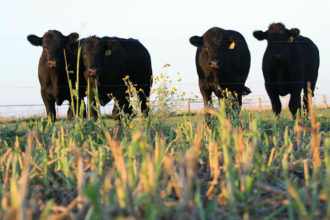BATON ROUGE, Louisiana – Over-seeding a diverse cool-season cover crop mix into a rotationally grazed warm-season grass pasture appears to improve soil health, especially when the system is managed over a longer period of time.
In a limited study, funded by a Southern Sustainable Agriculture Research & Education (SSARE) Graduate Student Grant, Louisiana State University researchers found that winter annuals incorporated into a bahiagrass pasture improved soil organic matter, while nitrate concentrations decreased, carbon concentrations stabilized, and soil microbial enzyme activity increased, suggesting a healthy soil environment.
“Livestock producers are always looking for ways to make their forage-based systems more economically and environmentally sustainable,” said LSU soil microbiologist Lisa Fultz. “If over-seeding winter annuals can improve soil health, then this may increase the soil biodiversity and biological activity, increase the soil organic carbon and nitrogen content, and maintain or increase forage production while possibly reducing synthetic fertilizer inputs.”
Fultz, along with graduate student Kathleen Bridges, focused on the pasture management systems of two cattle producers: one who had been mob grazing his pastures for eight years, and another who had three separate pastures that he had subjected to management for 0 years, 4 years, and 10 years. They compared the effects that the use of a winter annual mix of grasses (annual ryegrass, triticale, oats), legumes (hairy vetch), clover (crimson clover), and crucifers (radish and turnips) and rotational grazing had on soil health at any given time. Soil samples were collected and analyzed for physical, chemical and biological properties as bioindicators of soil health.
“By analyzing the soils of these sites for the same soil characteristics, it would provide information about how this management strategy has altered the soil from its previous uses and may give a predictive view of the soil health,” said Bridges.
Results showed that at one site soil organic matter increased six percent over the two-year study. “The increased soil organic matter with time may be due to the use of winter annuals which provide a constant source of plant biomass throughout the year when incorporated with warm-season perennials,” said Fultz.
Inorganic nitrogen concentration decreased by 80 percent within two years at one site, which researchers speculate was due to the lack of added fertilizers over the 8-year grazing period. However, total nitrogen did not decrease over time. “This suggests that there was enough organic nitrogen in the plant biomass and animal manure to replace the nitrogen lost through leaching, or that the inorganic nitrogen changed form and did not leave the site,” said Fultz.
Soil microbial enzyme activity increased with increasing years of management: by 32 percent at one site, and an average of 70 percent at another site. The longer winter annuals were incorporated into rotational grazing, the higher the enzyme activity. Researchers, however, found no change in the soil microbe community in structure or in abundance.
“It was unexpected to observe an increase of enzyme activity with increasing years of management without also seeing an increase of soil microbial abundance,” said Bridges.
The researchers also found that in some instances, topography had a greater influence on soil characteristics, and should not be overlooked in pasture management.
“This pasture management technique of over-seeding a diverse mix of winter annuals and rotational grazing without additional fertilizers or lime may, with time, allow for a steady state of carbon and nitrogen while soil organic matter increases and inorganic nitrogen decreases, and enhance their potential enzyme activity. These two sites have reached an equilibrium in which the outputs or losses from the systems equals the inputs to the systems or, in other words, sustainability,” said Bridges. “This research may influence future decisions of livestock producers in how they manage their grazing operations.”
More information on the Southern SARE project GS16-158, “Soil Health of a Warm-Season Perennial Pasture Over-seeded with Cool-Season Annuals,” can be found by searching the SARE projects database.
Published by the Southern Region of the Sustainable Agriculture Research and Education (SARE) program. Funded by the USDA National Institute of Food and Agriculture (NIFA), Southern SARE operates under cooperative agreements with the University of Georgia, Fort Valley State University, and the Kerr Center for Sustainable Agriculture to offer competitive grants to advance sustainable agriculture in America's Southern region. This material is based upon work that is supported by the National Institute of Food and Agriculture, U.S. Department of Agriculture, through Southern Sustainable Agriculture Research and Education, under sub-award number: GS16-158. USDA is an equal opportunity employer and service provider. Any opinions, findings, conclusions, or recommendations expressed in this publication are those of the author(s) and do not necessarily reflect the view of the U.S. Department of Agriculture.
